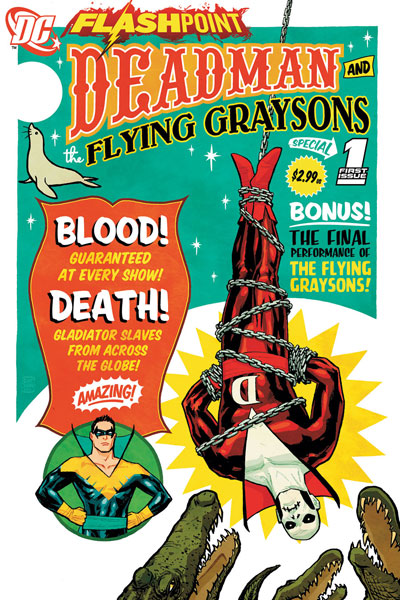Flashpoint – Deadman and the Flying Graysons 1
Reviewed by Peter Campbell 01-Jul-11
DC’s Flashpoint series seems to be latest attempt to simplify the DC universe and make it accessible to a wider readership. It happens every few years: some big, earth-shattering crisis that levels years of cross-continuity and increasingly self-referential storylines. Maybe it even works, for a little while, but it’s a doomed mission. Plotlines and characters accumulate again, history becomes baggage, and the comics become incomprehensible to a casual readership.
DC’s Flashpoint series seems to be latest attempt to simplify the DC universe and make it accessible to a wider readership. It happens every few years: some big, earth-shattering crisis that levels years of cross-continuity and increasingly self-referential storylines. Maybe it even works, for a little while, but it’s a doomed mission. Plotlines and characters accumulate again, history becomes baggage, and the comics become incomprehensible to a casual readership.
As part of this particular reboot, Deadman and the Flying Graysons finds Boston Brand and Dick Grayson working as trapeze artists in a travelling circus. They’re pitted as polar opposites. Brand is a loner: brilliant, arrogant and self-obsessed. Grayson is equally talented but more humble, and part of a close-knit family team. Also working in the circus are a number of other recognisable DC characters such as Dr Fate, King Shark and Rag Doll. They move across Europe in search of places where they can perform, attempting to avoid the war that has broken out, but which by the issue’s end seeks them out.
It’s fairly clear where all this is headed. From the few hints dropped throughout the storyline, Deadman is going to end up, well, dead, having learned humility and self-sacrifice along the way. Grayson will become Nightwing, and Deadman will float around in a creative void until the sales figures from this particular series dictate his reappearance as a regular series, or consign him to bit-part oblivion.
Predictable it may be, but writer JT Krul still manages to imbue the storyline with a fair amount of atmosphere. In fact, the backdrop comes across more strongly than the central characters. Brand’s arrogance and Grayson’s humility aren’t really more than props to move the storyline along, but there’s a sense of unease generated by tangential events– Dr Fate’s visions, an attack on a city by armour-clad Amazonians – that’s often very effective.
The primary attraction here though is the art. Mikel Janin is a new name to me, but on the evidence here he has real talent, and it’s particularly striking when viewed in the context of a mainstream superhero comic. It’s like a strange cross between Didier Eberoni and Liberatore, with the cheesecake elements extracted. There are noticeable flaws: the facial features of his characters sometimes have little to distinguish them, and the out-and-out superhero scenes in particular can seem clumsily composed, as though he hasn’t quite managed to get to grips with the genre. It’s still very striking, and is helped immeasurably by Ulises Arreola’s colouring which is absolutely stunning, all moody pastels and painterly textures.
Even with its evident weaknesses, this is a cut above many of the mainstream comics around at the moment. I wish I could say it bodes well for DC’s planned post-flashpoint universe, but I’m too old and cynical to make such a rash statement. Taken on its own though, this is a slightly off-beat and sometimes evocative comic that has me interested enough to follow its progress to the series’ conclusion.
Tags: DC, Deadman, JT Krul, Mikel Janin, Nightwing
Hey Peter, thank you for the compliments, and thank you for the fair critique too. I will keep in mind to give more difference to faces and try to get the mood for superheroes.
Kind regards,
Mikel